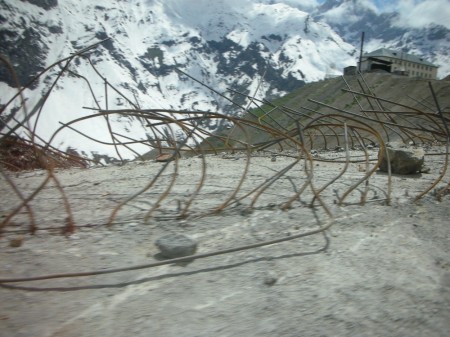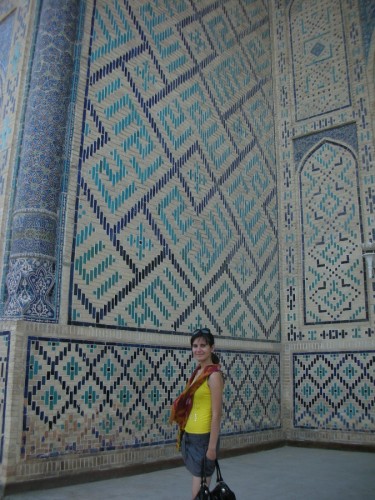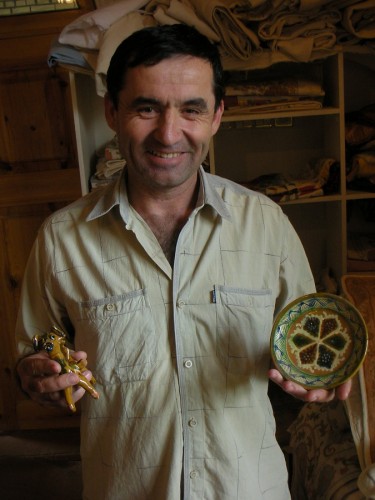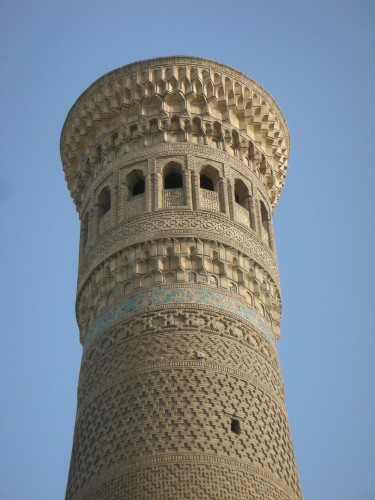After the 8 hours spent along the banks of the Panj River waiting for a mudslide to be cleared, I should have expected that there would be a good chance I’d see more of the same, and I was right. Malik and I were on our way towards the Tajiki city of Panjakent with our hired driver Shirehlee (yes, it is very close to how we’d say “Shirley”) through the snow-covered northern mountains when we were waylaid by a Chinese road construction team for four hours, joining yet another convoy. I thought I would be done with convoys! But such is life – the problem is that the Chinese building group had no idea when they’d be done, or when they started, or when they might stop, and even worse is that this isn’t communicated through any centralized radio network that a driver can tune into. As it was just the two of us and Shirehlee, Malik stretched out in the backseat and napped and I read the final chapters of the last book in the Dune Trilogy that I had gotten for Christmas, six months earlier.

The light and shadows through the rebar tunnel construction made for some interesting mountain scenery
When we at last rumbled into Panjakent at close to midnight, we were enthusiastically greeted by Rauof, the director of the Panjakent archeology facility and a very close friend of Malik’s. He entertained us late into the night with stories about his years working in Paris with such joviality and camaraderie that I thought for the first hour that he must have been Malik’s old university roommate or something. He poured us shot after shot of vodka, downing them all joyfully and with exquisite toasts to our health and families, his fluffy mop of salt and pepper colored hair bobbing erratically, giving him the look of a Central-Asian Andrew Jackson. His driver sat near by, a quiet young man who worked at the archeology excavation site just a few kilometers outside the city limits of Panjakent. Rauof and Malik offered him drinks, which he quietly declined – probably best for his employer’s safety on the ride home!
Our intention was to enter Uzbekistan by 9 in the morning, meet our tour guide at the border, and be in Bukhara just after lunch. However, disaster struck us at the border: the Uzbek guards refused to let Malik enter the country, saying that his official visa pass was not enough and in order for him to use this particular border entrance, he needed to have special faxed documentation for a travel necessity – random tourism of Bukhara was apparently not enough of a necessity. The problem is that the Uzbeks and the Tajiks dislike each other on principle, and the governments of each country even more so. The two border facilities on each side of the no man’s land, for example, weren’t even on speaking terms with each other. To make matters worse, the southeastern corner of Uzbekistan that contains the most famous cities and landmarks is essentially a part of Tajikistan because the majority of the people there identify as Tajik, including speaking Tajik instead of Uzbek languages! This is a sore idea for the Uzbek government which enjoys receiving loads of tourist money from these cities and certainly has no intention of returning the region to Tajikistan just because the inhabitants are Tajiki. It passed laws on those borders saying that neither Uzbeks nor Tajiks can cross that particular border there. Malik didn’t know for sure, but he speculated that it was because the Uzbek government is trying to prevent nationalist feelings of uprising or secession in their Tajiki holdings by limiting their access to Tajikistan, and vice versa. Whatever the case, I knew that I couldn’t just throw my $200 visa away – we still had our tour guide waiting for us, after all. I bid Malik a sad, worried farewell and took my first unguided, untranslated steps into Uzbekistan alone.
I was met by a thin, dour-faced young man named Akbar, a Samarqand native who would be my driver for the next four days. He spoke only a little English, and was a little put-off by the fact that I arrived alone, fact he communicated to me with his questioning sign printed with Malik’s name. Although Malik had written a note for me in Tajiki (which all Samarqand natives speak) for him, he still needed verification of this from the tour guide office before we could begin our four-hour drive to Bukhara.
Here so close to the border with Tajikistan, the villages and towns our white Chevy sedan passed through were quite similar to those that I’d seen for the past week, but the obvious differences were in the language – the official language of Uzbekistan uses the Roman alphabet instead of Cyrillic, and in fact looks and sounds a lot like Turkish. Good thing I’m now an expert on Turkish after my one day in Istanbul. The other very noticeable difference was in the mountains or lack thereof: after moving away from the border, the land quickly flattened out until everything looked like Wisconsin farmland as far as the eye could see, the mountains merely vague shadowy pillars on the horizon behind us.
By far the most surprising stop we made was in the middle of Samarqand, where Akbar got out, instructed me to wait a moment, and returned with a stack of money so large that I assumed he had robbed a bank and I was now an internationally-wanted criminal. It wasn’t until later that I learned that the Uzbek form of currency, the СУМ (or as we’d pronounce it, the saum), is extremely unwieldly, and goes by a base of 100 saum, with their largest note being only 1000 saum. This means, of course, that a lunch might be 7,000 saum, and a hotel room might be 30,000 saum – which would mean 7 or 30 notes. That 15 centimeter stack of notes that Akbar stuffed into the glove compartment next to me would only last a few days.
Before reaching the city, we stopped briefly at the workshop of the famous ceramic, pottery, and linencraft artisan, Abdullah Narzullav, who solemnly led me around his workshop, firing kiln room, and of course provided Akbar and I with fresh tea, berries, and nuts in some of his handmade ceramicwork. I learned that his family had been working in pottery for 6 generations, and when I looked over at his wall of photographs, I saw pictures of him presenting Queen Elizabeth and First Lady Hillary Clinton with half-meter wide plates, as well as a signed letter of thanks from Ms. Clinton. There were many other royalties there, like a prince of Saudi, but no one else I could name off the top of my head. I looked at the quiet, sedately-smiling Abdullah with new respect, and bought a few small items that I could fit into my luggage.
In only a half hour more, Akbar had deposited me at the front door of the Komil Boutique Hotel with a promise that he would pick me up the next morning at 8. The owner of the hotel was aptly named Komil, a young man only a little older than myself. Apparently, this hotel had been his family’s house for generations, and after he became the man of the house, he decided that the home’s beautiful carvings, both in stone and wood, were too beautiful to be kept to himself. Check out some of the pictures from his website, and definitely keep them in mind if you’re ever in the area. Komil told me he had called my guide and she was on her way here, giving me a half hour to shower and change after my long car ride.
I was met in the hotel’s reception room by my guide, a young woman named Bibi Khanum (“like the Samarqand princess,” she laughed, a comment I wouldn’t understand for another couple days) who was dressed in Western style, plus a colorful scarf and large East-coast sunglasses. She escorted me through Komil’s large wooden doors, and began the tour instantly by talking about the central part of the Old City, where we were now walking. Children ran about us, playing ball in the streets under the afternoon sun and the shadow of the low stone buildings surrounding us. She called a taxi for us, which transported us about two kilometers away to the northwestern part of the city to see the first stop on the tour, a large, extremely Middle-Eastern-looking castle made of sandy-colored stone, named simply Arq, or fortress. I paid a few thousand saum to enter the building, as Bibi chatted amicably with the vendors in the cool shade of the entrance hall. Of course she had seen them a hundred times before, and she confirmed that she had been to the Arq only two days earlier with another tour group. Because of the lateness of my arrival, many of the tourists had already left and several of the museums inside were closed, but Bibi was a good storyteller and did an excellent job describing the bloody, womanizing Emirs that had lived in this building throughout the centuries until the Soviets took over. I did some research after I returned to Jordan and found that, amazingly enough, there is a color photograph of the last emir, all the way back from 1911. Check it out; it looks like it was shot last week with a digital camera – that’s some excellent Russian technology for you. The emir looks exactly as Bibi described him – a corpulent, lustful slug of a man who brought nothing but taxation and fear to his people.
Speaking of cameras and photographs though, make sure to bring some extra currency with you when you’re in Central Asia; just like in Russia you are required to pay an extra fee for the privilege of taking photographs inside their monuments. I was a little put off by this at first because I felt it was a tourist trap – but then realized that of course it was a tourist trap, but at least they were being upfront about it. The admission prices were never more than 6,000 saum (about $4) anyway, so I didn’t mind an extra $.75-$1 to take some good photographs.
The two of us continued down the quiet streets of the Old City in a diagonal fashion until we reached the Po-i-Kalyan central mosque and madrasah, the largest single territory of monuments in the city. We weren’t allowed to go into the madrasah, which is still active and in use 700 years after its creation, but I stood in the inside gate and took some pictures of its exterior, which like most famous buildings on the Silk Road is liberally coated in brilliant ceramic tiles and artwork. Both Bibi and Abdullah had pointed out an interesting feature on all of the animals drawn or sculpted in Central Asia – because Islam forbids portrayals of living humans or animals, each creature is drawn or sculpted with its throat slashed, symbolically informing the populace that this artwork is not meant to depict something that is alive. It’s hard to see most of the time (purposefully kept small so as not to mar the artistry) but this small line or cut is on every animal painting or sculpture made in Central Asia. Scroll back up and check out the picture of the animal-shaped whistle in Abdullah’s right hand.
Between the mosque and madrasah is the solitary Kalyan Minaret, impressive in its height and ornate “stalactite” covered dome. This minaret had lasted longer than either of the other two buildings, said Bibi, because during the Mongol invasions led by Genghis Khan in the 12th century the legend goes that when Khan rode up to it while surveying the city, he supposedly looked around at the mosque and school, then up at the 48 meter tall minaret. As he did so, his turban fell to the ground from his head, which caused him to laugh aloud, proclaiming that this minaret had caused him to remove his hat in its presence and therefore it was to be spared from destruction.
Inside the large, almost empty mosque, the quiet whitewashed halls were almost maze-like in their uniformity and blankness, all facing inwards towards the large central courtyard with its single mulberry tree, a commonly seen sight in Central Asia as a symbol of life and family (and also for its oft-consumed tasty berries). As we examined the mi’hreb niche on the back wall towards Mecca, a small group of men finished their prayer in the inner chamber and exited, waving and “salaam”ing politely towards Bibi, who they probably saw every few days as part of her guiding duties.

Bibi at the entrance to the Mi'hreb niche at the back of the Po-i-Kalyan mosque. Behind her, the name of God - الله - is carved into the stone
Bibi led me through the local Trade Domes of the city, of which five still remain in use, still selling their wares as they have for centuries, coming from all corners of Asia and Europe for business. Except now the sellers are too often bored-looking young people selling refrigerator magnets, and the buyers are merely tourists like myself, more interested in taking pictures than doing business. I wish it was possible for me to see what places like the Trade Domes used to look like during the heyday of the Silk Road – my romanticized mental image of it probably can’t do it justice. Bibi encouraged me to poke my head into one of the last few remaining hammams (Turkish baths) in the city, where a young man wearing nothing but a towel and a wide smile told me that they were open 24 hours, 7 days a week, for a full body oil massage for just 35,000 saum. “Maybe next time,” I said; the smell of spices and incense in the room made me a little dizzy and I banged my head on the low door frame on the way out.
With the sun sinking over the horizon, I regretfully realized that it would be impossible for me to take any further pictures of the city, which also of course meant that any further sightseeing would be impossible, too (hey, me and my camera are a team; I can’t leave him out of the action!) – that, and I hadn’t eaten all day since that morning with Rauof and Malik. Bibi kindly took me to a plaza in the center of the old city, containing a pool and rounded with 400-year-old gnarled mulberry trees and open air kebab-selling cafes and bars. Coincidentally enough, we happened past her mother and two of her aunts as well who were out for an evening stroll. The three of them didn’t speak English, but I told them through Bibi’s translation that she was doing a wonderful job and I was writing everything down later. The stars winked in and out through the branches of the mulberry trees, and I was assisted by my helpful guide with ordering kebabs, salads, and soup – of course washed down with a local Uzbek brew, Sarbast. My soup was mouth-meltingly hot at first, but Bibi informed me that the Chaka, the bitter sour cream that came with the salad, had more uses than just a dressing (or apparently a shampoo stand-in; it’s apparently strong enough to remove dirt from hair) – mix it into the soup and the heat drops quickly to slightly more edible temperatures.
My touring day a success (although it was a bit rocky in the morning), I bid my wonderful tour guide goodnight at around , and returned to the Komil, getting pleasantly lost in the now-empty Trade Domes several times along the way. I let myself into the quiet hotel and was about to fall asleep on my large bed when I realized that there was a hard lump of something pressing into my hip. With a chuckle, I pulled out a thick wad of saum, about 50,000, and tossed it on the nightstand. If I wanted to, I could be a millionaire here!




No one has commented on this post - please leave me one, I love getting feedback!
Follow this post's comments, or leave a Trackback from your site